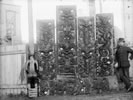James Cook’s voyages
The European interest in collecting, for both personal and scientific reasons, came to New Zealand with British navigator James Cook. Joseph Banks, botanist on the Endeavour, first went ashore at Poverty Bay on 11 October 1769, and he and the ship’s other scientists gathered some 40 plant specimens. Ten days later at Anaura Bay, north of Tolaga Bay, he collected many more plants and shot ‘some most beautifull birds’.1
As well as New Zealand plant and animal life, Europe was fascinated by Māori. Among the examples of Māori art collected during Cook’s first voyage was a rei puta – a whale-tooth breast pendant. Māori traditionally kept prized personal items, such as huia feathers for decorating the hair and greenstone hei tiki (neck ornaments), in intricately carved wooden boxes. These were known as waka huia or papanou, and were hung from the rafters of houses. One such treasure box obtained on Cook’s first voyage is held by the Museum of New Zealand Te Papa Tongarewa in Wellington.
During his three voyages to the Pacific, Cook collected an estimated 2,000 specimens of Māori art and culture. These found their way into private and museum collections in Britain, Sweden, Germany, Austria and Switzerland.
Proof of origin
The first piece of moa bone taken to London was shown to leading scientist Richard Owen. He did not believe it could be from New Zealand, and he was then shown some Māori artefacts which had been collected at the same time as the bone. He recognised them as ‘peculiar to the New-Zealanders’2 and accepted that the bone was from the same country, and from a bird similar in size to the ostrich.
Curiosities and specimens
Following the early European navigators, other individuals collected ‘curiosities’ in New Zealand. A small fragment of bone obtained by a flax trader in Poverty Bay was taken to London in 1839 and identified as being from a large and extinct flightless bird, soon to be known as the moa. Missionaries William Williams and William Colenso were also collecting large numbers of moa bones on the East Coast of the North Island, and these were shipped off to scientific experts in England. Native plants were collected by the likes of William Colenso, who sent specimens to scientists such as Joseph Dalton Hooker of the Royal Botanic Gardens, Kew, London.
Māori artefacts were desirable curiosities. James Butterworth of New Plymouth collected and traded these items from around 1867 until his death in 1903.
Collections on show
The 1851 Great Exhibition at the Crystal Palace in London, known as the first world fair, was a huge popular success. The first such event in New Zealand was the New Zealand and South Seas International Exhibition in Dunedin in 1865. It gave individuals the chance to show off their own collections. One of these was a display of 190 birds of Otago, amassed by James Hector, a geologist and later the first director of the Colonial Museum in Wellington.
Augustus Hamilton, the next director of the Colonial Museum, was also a keen collector. He displayed his own collection of sponges from Hawke’s Bay at the 1885 Industrial Exhibition in Wellington.
Supplying the fern craze
In the late 1890s Eric Craig’s Museum in Princes Street, Auckland, sold ferns for collectors. His specimens were mounted or unmounted, and in sets, boxes or albums with decorative covers. In 1901 Craig claimed to have the largest private collection in Australasia. He sold items sourced from New Zealand and around the Pacific, including shells, corals and kauri gum (rough, polished and made into ornaments), and had over 200 Māori carvings in stock.
Fashions
Fern collecting was popular in New Zealand in the 19th century. Among the ferns shown at the 1865 exhibition in Dunedin was a collection made by students of St John’s College, Auckland. Various types of ferns – framed, pressed and bleached – were featured in the 1889–90 New Zealand and South Seas Exhibition in Dunedin.
Stamp collecting started in New Zealand in the mid-1880s and became very popular, particularly with children and men. In the early 20th century postcards were another popular collectable.




